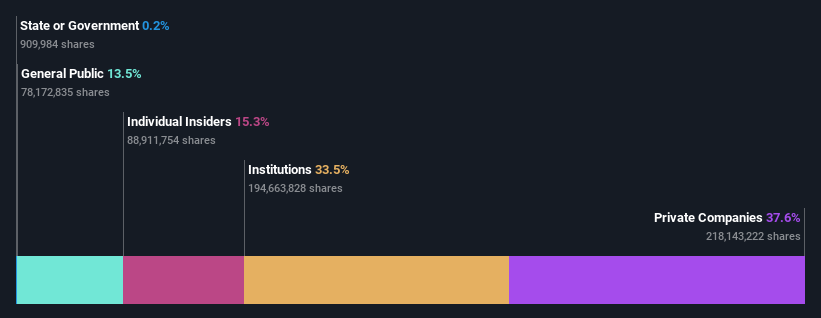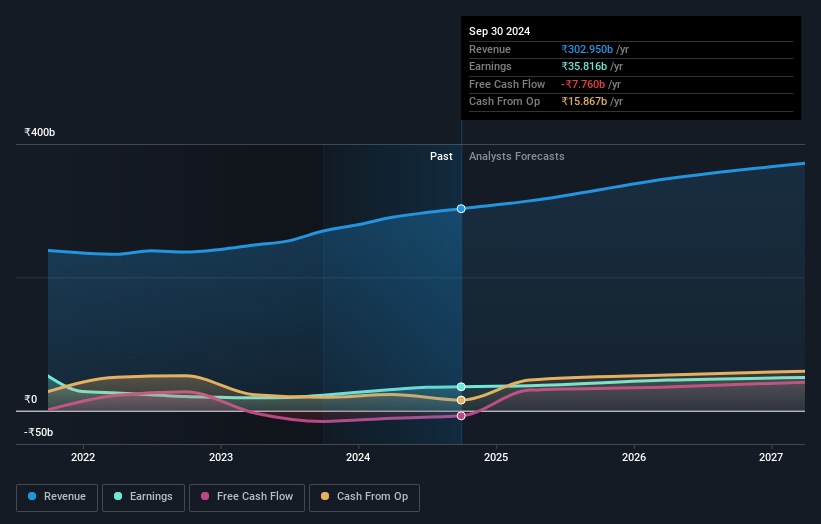Aurobindo Pharma Limited (NSE:AUROPHARMA) surges 3.9%; private companies who own 38% shares profited along with institutions

Key Insights
- Significant control over Aurobindo Pharma by private companies implies that the general public has more power to influence management and governance-related decisions
- The top 5 shareholders own 53% of the company
- 15% of Aurobindo Pharma is held by insiders
A look at the shareholders of Aurobindo Pharma Limited (NSE:AUROPHARMA) can tell us which group is most powerful. The group holding the most number of shares in the company, around 38% to be precise, is private companies. Put another way, the group faces the maximum upside potential (or downside risk).
Private companies gained the most after market cap touched ₹766b last week, while institutions who own 34% also benefitted.
Let's delve deeper into each type of owner of Aurobindo Pharma, beginning with the chart below.
Check out our latest analysis for Aurobindo Pharma

What Does The Institutional Ownership Tell Us About Aurobindo Pharma?
Institutional investors commonly compare their own returns to the returns of a commonly followed index. So they generally do consider buying larger companies that are included in the relevant benchmark index.
We can see that Aurobindo Pharma does have institutional investors; and they hold a good portion of the company's stock. This implies the analysts working for those institutions have looked at the stock and they like it. But just like anyone else, they could be wrong. It is not uncommon to see a big share price drop if two large institutional investors try to sell out of a stock at the same time. So it is worth checking the past earnings trajectory of Aurobindo Pharma, (below). Of course, keep in mind that there are other factors to consider, too.

Hedge funds don't have many shares in Aurobindo Pharma. Penaka Family Trust is currently the largest shareholder, with 34% of shares outstanding. Kambam Reddy is the second largest shareholder owning 5.6% of common stock, and ICICI Prudential Asset Management Company Limited holds about 4.7% of the company stock. Kambam Reddy, who is the second-largest shareholder, also happens to hold the title of Chief Executive Officer.
Our research also brought to light the fact that roughly 53% of the company is controlled by the top 5 shareholders suggesting that these owners wield significant influence on the business.
Researching institutional ownership is a good way to gauge and filter a stock's expected performance. The same can be achieved by studying analyst sentiments. There are plenty of analysts covering the stock, so it might be worth seeing what they are forecasting, too.
Insider Ownership Of Aurobindo Pharma
The definition of company insiders can be subjective and does vary between jurisdictions. Our data reflects individual insiders, capturing board members at the very least. The company management answer to the board and the latter should represent the interests of shareholders. Notably, sometimes top-level managers are on the board themselves.
I generally consider insider ownership to be a good thing. However, on some occasions it makes it more difficult for other shareholders to hold the board accountable for decisions.
Our information suggests that insiders maintain a significant holding in Aurobindo Pharma Limited. It has a market capitalization of just ₹766b, and insiders have ₹117b worth of shares in their own names. That's quite significant. Most would say this shows a good degree of alignment with shareholders, especially in a company of this size. You can click here to see if those insiders have been buying or selling.
General Public Ownership
The general public, who are usually individual investors, hold a 13% stake in Aurobindo Pharma. While this size of ownership may not be enough to sway a policy decision in their favour, they can still make a collective impact on company policies.
Private Company Ownership
Our data indicates that Private Companies hold 38%, of the company's shares. It might be worth looking deeper into this. If related parties, such as insiders, have an interest in one of these private companies, that should be disclosed in the annual report. Private companies may also have a strategic interest in the company.
Next Steps:
While it is well worth considering the different groups that own a company, there are other factors that are even more important.
I always like to check for a history of revenue growth. You can too, by accessing this free chart of historic revenue and earnings in this detailed graph.
If you are like me, you may want to think about whether this company will grow or shrink. Luckily, you can check this free report showing analyst forecasts for its future.
NB: Figures in this article are calculated using data from the last twelve months, which refer to the 12-month period ending on the last date of the month the financial statement is dated. This may not be consistent with full year annual report figures.
New: Manage All Your Stock Portfolios in One Place
We've created the ultimate portfolio companion for stock investors, and it's free.
• Connect an unlimited number of Portfolios and see your total in one currency
• Be alerted to new Warning Signs or Risks via email or mobile
• Track the Fair Value of your stocks
Have feedback on this article? Concerned about the content? Get in touch with us directly. Alternatively, email editorial-team (at) simplywallst.com.
This article by Simply Wall St is general in nature. We provide commentary based on historical data and analyst forecasts only using an unbiased methodology and our articles are not intended to be financial advice. It does not constitute a recommendation to buy or sell any stock, and does not take account of your objectives, or your financial situation. We aim to bring you long-term focused analysis driven by fundamental data. Note that our analysis may not factor in the latest price-sensitive company announcements or qualitative material. Simply Wall St has no position in any stocks mentioned.
About NSEI:AUROPHARMA
Aurobindo Pharma
A biopharmaceutical company, engages in the manufacture of generic formulations and active pharmaceutical ingredients in India, the United States of America, Europe, Puerto Rico, and internationally.
Excellent balance sheet and good value.
Similar Companies
Market Insights
Community Narratives




